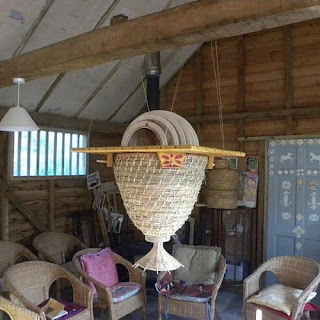I subscribe to Milkwood.net and get their latest updates on my reader.
When this arrived I was excited - not because I keep bees - but because for once the focus was on the bees, not on what we can obtain directly from them in the form of their honey.
 |
| Photo source: http://milkwood.net/2013/03/05/the-sun-hive -experiments-in-natural-beekeeping/ |
We all know where we would be without the bees...
 |
| Photo source: http://milkwood.net/2013/03/05/the-sun-hive-experiments-in-natural- beekeeping/ |
 |
| Photo source: http://milkwood.net/2013/03/05/the-sun-hive- experiments-in-natural-beekeeping/ |
And I just love the fact that the hives are woven. Naturally, they'd need to be protected somewhat from the damp, otherwise I could forsee their falling apart pretty quickly.
But - going more natural - in all things. Perfect, I reckon :)
And all it took was some lateral thought LOL
That's a beautiful hive! And I love this idea. Wonder if they would work in our neck of the woods. Are you going to order one?
ReplyDeleteDFW - Nope, don't think I will. I know of at least two "neighbours" who probably have 14 - 16 hives between them, so reckon there could be enough in our immediate area :)
DeleteI think that is so beautiful! I've never see anything like that? It's so humid here I'd worry about it holding up over the long term but I've wanted bees so bad and that's just stunning. Heck, it be a beautiful work of art all on it's own. Thanks for the info. :-)
ReplyDelete1st Man - I loved it for it's aesthetic value too - absolutely stunning :)
DeleteI keep reading of CCD or colony collapse disorder. I am happy to say that although we do not keep bees here, that many people locally do. I do buy local honey also. I am very appreciative of the bees and we work hard never to use insecticides because they inadvertently damage populations of bees. Instead we use IPM or Integrated Pest Management techniques, which of course, vary all over the country and the world, depending upon where you are. For example, we buy ladybugs (or ladybirds if you are in the UK) and liberate them at sundown. They following year, they eat a sufficient number of the tick eggs to decrease the adult form of these insects substantially.
ReplyDeleteThanks for your great post, Dani !
Jane - Ladybirds - how clever. I never knew that you could buy them - by the thousands?
Delete"Liberating at sunset" - literally - open the container and let them go? Won't most of them fly off to far off places? And what time of the year do you "liberate" them?
Please - would love any info you have... :)
Hi Dani. These guys, http://www.duroibugs.co.za, supply them. By the thousands, yes. We use the ladybirds and the wasps to control mealybug in our vineyard.
Deletecavereweb - You're a star. Thank you very much :)
Delete